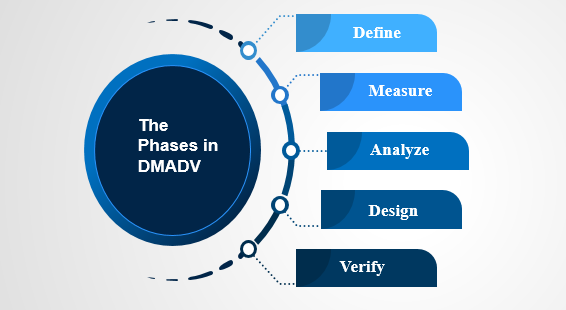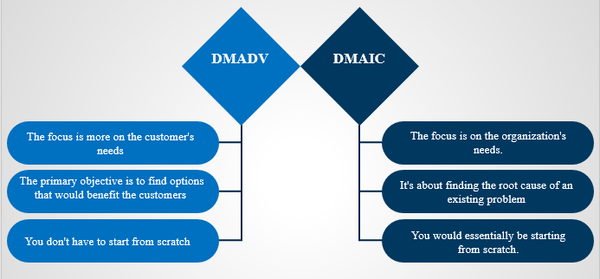The DMADV Methodology: What It Is And How It Works?
Six Sigma has been helping companies meet their project goals and deadlines since 1986, when Motorola was first introduced. Within Six Sigma, various methodologies can be used for problem-solving and process improvement. And one of them is DMADV, the other one being DMAIC.
Most people are familiar with DMAIC but not with DMADV. In this article, learn everything you need to know about the DMADV methodology.

What Is DMADV?
DMADV is one of the two Six Sigma methodologies used to achieve the Six Sigma level of performance. It stands for Define-Measure-Analyze-Design-Verify, which are the five phases of this methodology.
As a project manager or six sigma practitioner, you will use this methodology when there's a need to create a new project or product.
Implementing DMADV requires that the person managing the project have a Six Sigma Green, Black, and Master Belt certification. It also demands support from a Project Owner and/or Process Owner for successful execution.
The Phases In DMADV
As mentioned above, DMADV is made up of five steps, which are:

Let's explore each of the five phases in greater detail.
1. Define:
The first phase is all about getting your vision right, because of which this phase is perhaps the most important. First, you're required to define the purpose and expectations of the project, process, or service. Based on that, you then set actionable and achievable goals.
In the define phase, your goal is to define clear definitions that are understood by all the company stakeholders. Therefore, you should act from the organization's point of view rather than from a project manager's perspective.
Along with that, you develop the policies, guidelines, and potential risks for the project.
2. Measure :
Once the project or process is underway, the next phase is the measurement phase. Towards the end of phase one or the beginning of this phase, you should define CTQs or Critical to Quality metrics.
These metrics will help you decide if your processes are up to the mark or need reassessment.
In detail, here are the things you need to work on:
Define requirements and market segments
Define critical design parameters
Design scorecards to evaluate different design components
You should also define all project-specific factors that are important to the quality and production process.
3. Analyze :
The next phase is about analyzing the process and recording the metrics/factors you've defined in the previous phase.
The analysis phase will include the following:
- To develop design alternatives.
- To figure out the best combination of requirements to deliver the best results.
- To develop conceptual designs.
- To evaluate each component and select the best ones
Unlike other phases, analysis is going to be a continuous phase. You’re likely going to run multiple analyses of a process. After the first few analysis, the project team can create the baseline for improvement. This will guide the entire team towards process optimization and help figure out the best process.
4. Design :
Next comes the design phase. This is another critical phase that largely determines the success of your project. Therefore, don't be shy from devoting more time to this phase.
The process expert should take the lead for this phase rather than a Six Sigma expert. That's because he is the one who is familiar with the minute details of the process.
The process, along with the team, should look at the inputs from the analysis phase. Then cherrypick the components that they believe will have the best impact on the project or process. Based on the components, the team moves toward a high-level design.
5. Verify :
The final phase of the DMADV Six Sigma methodology is the verification or verify phase. The team and all the stakeholders validate that the design is up to the mark. It's required that you run several pilot processes and production before approving a project or process for real-world applicability.
Once the expectations are confirmed by the Six Sigma team and higher management, you can expand the deployment. In this phase, developing a plan that details transitioning the product to a routine operation is also recommended. Along with that, the plan should ensure that this transition is sustainable.
So those were the five phases of DMADV methodology. Each phase is important in its own way. So devote adequate time to each phase for building a profitable product or service.
When Is DMADV Used?
There are various Six Sigma methodologies. Therefore, knowing when to adopt a particular method for your process is important.
Generally, DMADV is used for new and nascent projects. For example, after identifying a problem or spotting a market opportunity, you'll feel the need to start a new project. Ideally, you'd want it to start delivering results from the very beginning. That's when you'd have to use the DMADV methodologies by following the five phases.
At the core of DMADV is understanding customer's expectations. Then, you design CTQs to correlate to the quality parameters that would satisfy the customers' needs. Therefore, you can also use DMADV for redesigning an existing process or product.
Difference Between DMAIC & DMADV
DMAIC and DMADV are two common Six Sigma methodologies. Both of them share the same vision, which is to achieve Six-Sigma-level performance. They also share common phases, but they're used under different circumstances. Therefore, one cannot be used to replace the other.

The main difference is that you would use DMAIC (Define-Measure-Analyze-Improve-Control) to improve an existing process. At the same time, you would employ the DMADV methodology for a completely new process or project.
Besides that, here are some key differences:
- In DMADV, the focus is more on the customer's needs, while in DMAIC, the focus is on the organization's needs.
- In DMADV, the primary objective is to find options that would benefit the customers. In DMAIC, it's about finding the root cause of an existing problem.
- In DMADV, you don't have to start from scratch. However, in DMAIC, you would essentially be starting from scratch.



